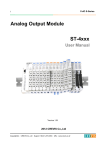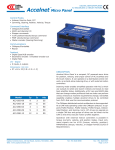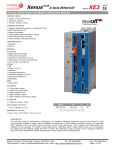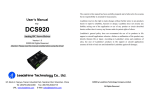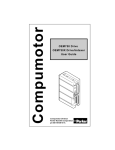Download 4xx2P - Copley Controls
Transcript
MODELS 4122, 4212 AND VARIANTS “P” VERSIONS FOR PC BOARD MOUNTING MODEL 4122P 4212P 4122ZP 4212ZP FEATURES • Mounts on customers printed circuit boards. • Uses output filter option for reduced PWM noise to adjacent circuits FEATURES +24~90VDC, 10/20A, Standard 0-100% modulation +24~90VDC, 6/12A, Standard 0-100% modulation +24~90VDC, 10/20A, 50% modulation +24~90VDC, 6/12A, 50% modulation APPLICATIONS • OEM drive systems THE OEM ADVANTAGE • Minimize cabling for lowest cost products • Uses industry-standard connectors for solderless installation FEATURES These versions of the 4122/4212 models and their variants use extended pins that interface with printed circuit board mounted connectors for direct mounting of the amplifier to customers pc boards. Pins models also accept the “F” option card that has output ‘edge’ filters that reduce the noise coupling of PWM outputs to adjacent cabling and circuitry. Copley Controls, 20 Dan Road, Canton, MA 02021 Web: http://www.copleycontrols.com Tel: 781-828-8090 The output filter card option uses the same connectors as the popular 300 series models ( 303, 306, 306A and variants ) for easy upgrading to the 4xx2 models. The filter is a dual section L/C/R that slows down the switching ‘edges’ ( the rise and fall times of the outputs ) for greatly reduced coupling of PWM noise to nearby cables and circuits. Fax:781-828-6547 Page 1 of 1 MODELS 4122, 4212 AND VARIANTS “P” VERSIONS FOR PC BOARD MOUNTING FILTER DIAGRAM R AMPLIFIER C2 L OUT(+) C1 GND MOTOR L C1 OUT(-) C2 R FUNCTIONAL DIAGRAM * JP1: PINS 2-3 FOR /ENABLE AT J2-11 PINS 1-2 FOR /INHIBIT AT J2-11 INTEGRATOR RESET SWITCHES TURN ON WHEN AMP IS DISABLED RH2 100 K AUX 16 LED TACH LEAD TACH (-) RH4 6 GND + 11 *JP1 INTEGRATOR - 10 3 2 1 7 RH3 4 - REF(-) 5 + 100 K REF LEAD RH6 CH8 REF AMP Gv = 1 REF(+) CH5 CH9 RH10 (OPEN) CH11 * *DEFAULT VALUE OF CH11 IS 0 OHMS NOTE: + SERVO PREAMP FOR TORQUE MODE OPERATION FOR VELOCITY MODE ( BRUSH TACH ) REPLACE CH11 WITH 4.7NF CURRENT LIMIT SECTION + 9 CURRENT MONITOR 8 GND 2 15 MOMENTARY SWITCH CLOSURE RESETS FAULT WIRE RESET TO GROUND FOR SELF-RESET CH14 RH1 10 MEG J2 SIGNAL CONNECTOR PEAK TIME VALUE DEPENDS ON MODEL SEE "ARMATURE INDUCTANCE" TABLE CURRENT ERROR AMP 47K 0.47U OUTPUT CURRENT SENSE Voltage gain = 1 J1 MOTOR & POWER CONNECTOR PWM STAGE MOSFET "H" BRIDGE 4.8 kHz FILTER 1 VOLTAGE GAIN 3 Gv = +HV 10 4 +/-6V at +/-Ipeak 1K MOTOR + 2 +/-6V for +/-Ipeak 33NF +FAULT OUTPUT RESET + RH13 4.7MEG 1K 33NF NEG ENABLE 14 RH15 -15V CURRENT REF 12 13 CH16 47K RH12 182K +15V BALANCE 50K CH17 PEAK CURRENT CONT CURRENT CW +5V STATUS & CONTROL LOGIC * ENABLE POS ENABLE 60.4 K 100PF RH7 100 K GREEN = NORMAL RED = FAULT GND 5 - MOTOR + MOTOR GND GND +HV 4.8 kHz FILTER 1K +HV +15 AUXILIARY DC OUTPUTS -15 1 3 10k +15V +5 +15 10k -15V DC / DC CONVERTER CASE MAY BE GROUNDED FOR SHIELDING -15 CASE GROUND NOT CONNECTED TO CIRCUIT GROUND POWER GROUND AND SIGNAL GROUNDS ARE COMMON Copley Controls, 20 Dan Road, Canton, MA 02021 Web: http://www.copleycontrols.com Tel: 781-828-8090 Fax:781-828-6547 Page 2 of 2 MODELS 4122, 4212 AND VARIANTS “P” VERSIONS FOR PC BOARD MOUNTING TYPICAL CONNECTIONS TORQUE MODE ENCODER VELOCITY MODE REF+ REF- 4 1 J2 5 ENCODER + J1 REF+ MOTOR 2 REF- 4 + 1 J2 J1 5 MOTOR 2 6 J2 + 7 GND 10 ENABLE 11 3 POS ENABLE 12 J1 4 NEG ENABLE 13 5 GND GND + +HV Note: JP1 on pins 2-3 ( default ) TACH 10 ENABLE 11 POS ENABLE 12 NEG ENABLE 13 3 J1 4 5 GND + +HV Note: JP1 on pins 2-3 ( default ) Notes 1. All amplifier grounds are common (J1-3, J1-4, J2-2, J2-7, and J2-10 ) Amplifier grounds are isolated from case & heatplate.. 2. Jumper JP1 default position is on pins 2-3 for ground active /Enable input ( J2-11 ) For /Inhibit function at J2-11 ( +5V enables ), move JP1 to pins 1-2 3. For best noise immunity, use twisted shielded pair cable for reference and tachometer inputs. Twist motor and power cables and shield to reduce radiated electrical noise from pwm outputs. Copley Controls, 20 Dan Road, Canton, MA 02021 Web: http://www.copleycontrols.com Tel: 781-828-8090 Fax:781-828-6547 Page 3 of 3 MODELS 4122, 4212 AND VARIANTS “P” VERSIONS FOR PC BOARD MOUNTING CONNECTORS AND PINOUTS J1: MOTOR & POWER CONNECTIONS Pin 1 2 3 4 5 Signal Motor (+) Motor (-) GND GND +HV Remarks Amplifier output to motor (+) winding Amplifier output to motor (-) winding Power supply return. Connect to system ground at this pin. Power supply return. Connect to system ground at this pin. +HV DC power supply input J2: AMPLIFIER BOARD CONNECTIONS Pin Signal 1 2 3 4 5 6 7 8 9 10 11 +15V Gnd -15V Ref (+) Ref (-) Tach (-) Gnd / Tach (+) Curr Mon Curr Ref Gnd /Enable 12 /Pos Enab 13 /Neg Enab 14 /Normal 15 /Reset 16 Aux Remarks +15V in series with 10kΩ Signal ground -15V in series with 10kΩ Differential input positive terminal for Reference voltage Differential input negative terminal for Reference voltage Negative terminal of brush tachometer Signal ground, or positive terminal of brush tachometer Output current monitor: ±6V output at ±peak output current Current demand signal to PWM stage: ±6V demands ±peak current Signal ground Amplifier enable input: enables or inhibits PWM switching at outputs Default: Gnd enables amplifier, open or +5V inhibits ( JP1 @ 2-3 ) For controllers that output +5V to enable amplifier, move internal jumper JP1 to pins 1-2 ( Gnd will inhibit, +5V or open will enable ) Gnd to enable output current in one polarity, open or +5V to inhibit Typically used with grounded, normally closed limit switches. Gnd to enable output current in opposite polarity, open or +5V to inhibit. Typically used with grounded, normally closed limit switches. Current-sinking when amplifier enabled and operating normally. Goes to +5V when amplifier disabled or fault condition exists. Ground to reset overtemp or output short circuit latching faults. For automatic reset of faults every 200mS, ground permanently. Single-ended auxiliary input. BALANCE POTENTIOMETER Default position: centered. Functions to bring output current ( in torque mode ) or output velocity ( in tachometer mode ) to zero with reference input voltage at zero, or control system output at zero. Normal range is ±1% of full scale with 10Meg resistor in header location RH1. To use the pot as a wide range set-point adjustment, install a 150kΩ resistor at RH1. Now, full CW or CCW will have the effect of a ±10V signal at the reference inputs. STATUS LED Dual color, red/green. Color Green Red Note +HV Normal Too low or too high X X X 1, 5 /Enable Active X Inhibited X X 2, 5 Short None X X Output short X 3, 5 Overtemp Normal X X X Too hot 4, 5 Notes: 1. +HV normal >20V and <92V for model 4122, >20V and <129V for model 4212 2. /Enable is ground-active for JP1 on pins 2-3 ( default ). To reverse function, switch JP1 to pins 1-2. 3. Shorts detected by overcurrent circuit are between outputs, or from outputs to ground. 4. Overtemperature faults occur when heatplate temperature is >70°C 5. +HV and /Enable cause momentary amplifier shutdown, operation is restored when +HV is within normal limits and /Enable input is active. Output shorts, and overtemperature faults latch-off amplifier. Thus amplifier will remain off until power is cycled on/off, or /Reset input is grounded momentarily. If /Reset input is wired to ground, output short and overtemperature faults will self-reset every 200ms. Copley Controls, 20 Dan Road, Canton, MA 02021 Web: http://www.copleycontrols.com Tel: 781-828-8090 Fax:781-828-6547 Page 4 of 4 MODELS 4122, 4212 AND VARIANTS “P” VERSIONS FOR PC BOARD MOUNTING COMPONENT HEADER NO PARTS INSTALLED IN THESE LOCATIONS CH17 CH16 LOAD INDUCTANCE COMPENSATION (SEE CHART FOR VALUES) RH15 JP1 3 2 1 J1 J2 1 5 16 1 COMPONENTS LABELLED "SEL" ARE NOT INSTALLED AT FACTORY USER SHOULD SELECT VALUES AS REQUIRED 0.47UF CH14 PEAK TIME LIMIT 4.7 MEG RH13 CONTINUOUS CURRENT LIMIT PEAK CURRENT LIMIT 182K RH12 (O OHM) CH11 60.4K RH10 PREAMP DC GAIN & INTEGRATOR (SEL) CH9 PREAMP HI-FREQUENCY ROLL-OFF (SEL) CH8 REF INPUT LEAD CAPACITOR 100K RH7 REFERENCE INPUT SCALING (SEL) RH6 REF INPUT LEAD RESISTOR (SEL) CH5 (SEL) RH4 100K RH3 TACH INPUT SCALING 100K RH2 AUX INPUT 10MEG RH1 BALANCE RANGE TACH INPUT LEAD NETWORK ARMATURE INDUCTANCE Model Load (mH) 0.2 to 0.5 0.6 to 1.7 1.8 to 4.8 5 to 14 15 to 45 RH 15 80.6k 200k 402k 806k 1.5M 4122 CH17 2.2 nF 680 pF 680 pF 680 pF 470 pF CH16 390 pF 220 pF 180 pF 150 pF 100 pF RH15 69.8 k 100 k 301 k 698 k 1.21M 4212 CH17 2.2 nF 1 nF 470 pF 330 pF 220 pF CH16 390 pF 330 pF 100 pF 82 pF 82 pF Note: Values in bold & italics are factory installed standard. Values shown are for 90V (4122 ) and 125V (4122). At lower supply voltages RH15 may be increased and CH17 decreased. PEAK CURRENT LIMIT (AMP) 4122 20 16.7 13.3 10 6.7 3.3 4212 12 10 8 6 4 2 CONTINUOUS CURRENT LIMIT (AMP) RH12 (Ω) 182k 56k 30k 18k 9.1k 3.9k CH14 (μF) 0.47 0.33 0.22 0.15 0.10 .047 Copley Controls, 20 Dan Road, Canton, MA 02021 Web: http://www.copleycontrols.com 4212 6 4.4 3.4 RH13 (Ω) 4.7Meg 7.15Meg 10Meg Notes on Current Limits: PEAK CURRENT TIME-LIMIT (SEC) Tpeak 1 0.8 0.5 0.3 0.2 0.1 4122 10 7.4 5.7 1. Values in bold & italics are factory installed standard. 2. Peak times double after polarity reversal. 3. Peak current limit should be set greater than continuous current limit. If Ipeak < Icont then peak overrides continuous limit and Icont = Ipeak. Minimum setting for peak current is 0% of peak rating. 4. Continuous current sense is for average current. Symmetrical waveforms with zero average value may cause overtemperature shutdown of amplifier or motor damage 2 due to high I R losses. 5. Times shown are for 100% step from 0A with default value of RH13 ( 4.7 Meg ). When changing RH13, peak times will change. Set RH13 for continuous current limit first, then pick CH14 based on waveforms at Curr Ref ( J2-9 ). Tel: 781-828-8090 Fax:781-828-6547 Page 5 of 5 MODELS 4122, 4212 AND VARIANTS “P” VERSIONS FOR PC BOARD MOUNTING APPLICATION INFORMATION IMPORTANT! ALWAYS REMOVE POWER WHEN CHANGING HEADER PARTS!! OPERATING MODES These amplifiers operate as either open-loop current sources, or feedback devices using analog tachometers. As open-loop current sources, the ±10V at the reference inputs produce current in the load, typically a motor. The motor acts as a transducer, and converts current into torque, the twisting force at the motor shaft. This is called torque mode. It is used most frequently in systems that have controllers taking feedback from an encoder on the motor shaft. The computer calculates both position and velocity from the encoder signal, processes them in a digital filter, and outputs a signal to the motor causing it to accelerate or decelerate. As a feedback amplifier, a signal is generated by an analog brush tachometer mounted on the motor. This is a generator that produces an analog signal that has a polarity and amplitude proportional to the motor speed. The amplifier subtracts the tach signal from the reference signal, and amplifies the difference between them. This is called velocity mode, because the amplifier changes the motor current ( torque ) so that the motor velocity is proportional to the reference signal. TORQUE MODE OPERATION Torque mode is the default configuration. For input voltages of ±10V, the amplifier will output its peak rated current. In torque mode, motor current is held constant, and motor speed, or velocity changes as the load changes. In torque mode the gain of the servo preamplifier is simply 0.6 and scales the ±10V from the reference signal down to the ±6V that drives the PWM stage. The servo preamplifier integrator function is disabled, and the low gain is constant over a wide range of frequencies. Thus we sometimes call this flat-gain mode. VELOCITY MODE OPERATION The difference between the reference and tachometer signals is amplified and used to change the torque on the motor. Ideally, the difference between the command and feedback signals would be zero, so in velocity mode operation the servo preamplifier must have much higher gain than when in torque mode. In addition, the gain must change over a range of frequencies. For “stiffness” that corrects for steady-state changes, the amplifier uses an integrator. For fast response the loop gain of the servo preamplifier must be tailored to the characteristics of the motor and tachometer. To control oscillations from the tachometer, the gain of the preamplifier must roll-off, or decrease at higher frequencies. In velocity mode, motor speed is held constant, while motor current changes in response to changes in the load. THE PARTS OF THE AMPLIFIER DIFFERENTIAL AMPLIFIER The reference signal ( the command signal from the control system ) is sensed by a differential amplifier. This acts like a voltmeter with two probes, measuring a voltage between two points. Current flowing in the amplifier power wiring causes voltage drops in the wires resistance. This in turn can produce a Copley Controls, 20 Dan Road, Canton, MA 02021 Web: http://www.copleycontrols.com voltage at the amplifier ground that is different than the control system ground. If this voltage is added to the output of the control system, it can produce oscillation, or inconsistent operation. To eliminate this effect, you should always use both reference inputs. Connect the Ref(+) input to the output of the controller card, and the Ref(-) input to ground at the control card. Now, the differential amplifier will measure the control signal at the control card and will reject any noise that exists between amplifier and control system grounds. THE SERVO PREAMPLIFIER This section processes the reference signal and any feedback signals, and generates an internal current reference signal that controls the PWM stage to produce output currents. It is here that the reference signal and tachometer signals are compared, and the difference signal produced and amplified. Three components on the header control the behavior of the servo preamp. The chart below lists the default torque-mode and starting-point values for velocity mode operation: Part CH9 RH10 CH11 Torque out 60.4k short Velocity 220pF 680k 4.7nF CH9 controls the high-frequency roll-off. RH10 controls the loop gain, and thus the step-response of the amplifier. CH11 ( along with RH7 ) forms the integrator that gives the stiffness at a standstill, or speed regulation while running. CURRENT LIMITING This stage takes the output of the servo preamplifier, and processes it before sending it to the PWM stage. The amplitude of the signal is first clamped to produce peak current limiting. This signal then goes to the continuous current-limit circuit where these functions are produced. Finally, the current-limited signal is outputted to the PWM stage as the current-reference signal. This signal is quite useful in that the current limit action can be seen here and measured without connecting a motor, thus protecting it from overload during initial setup. PWM STAGE The voltage at the output of the current limit stage is called the current reference. This signal becomes the demand signal that controls the PWM stage. Here the current demand is converted into a current in the motor. This current can be measured at the current monitor, which shows the response of the motor to the current demand signal. By operating as a current source, the PWM stage is able to achieve faster response from the motor than if was acting only as a variable voltage. The current error amplifier compares the current reference with the current monitor, and adjusts the output voltage such that the demanded current flows in the motor. The gain of this amplifier is controlled by RH15, CH16, and CH17, which are used to compensate the amplifier for the motors’ inductance. 1) Tel: 781-828-8090 Fax:781-828-6547 Page 6 of 6 MODELS 4122, 4212 AND VARIANTS “P” VERSIONS FOR PC BOARD MOUNTING OUTLINE DIMENSIONS Dimensions in inches (mm.) 0.56 2.00 4.00 3.00 0.625 1.00 0.16 4.30 ORDERING GUIDE Model 4122 Model 4212 20A peak, 10A continuous, +22 to +90VDC brush motor amplifier 12A peak, 6A continuous, +22 to 125VDC brush motor amplifier Copley Controls, 20 Dan Road, Canton, MA 02021, USA Tel: 781-828-8090 Fax: 781-828-6547 Web: http://www.copleycontrols.com Rev B, 06/08/2010








